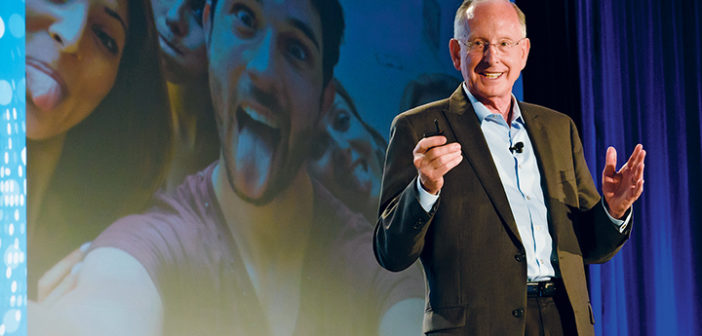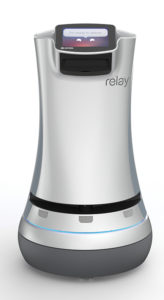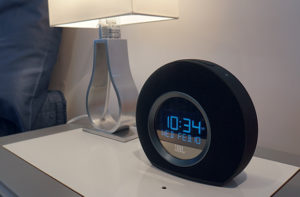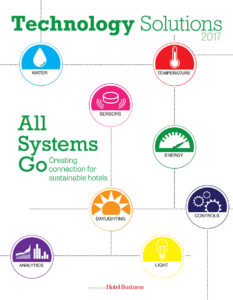TORONTO—Automation, robotics, artificial intelligence (AI). These words come up all the time in hospitality circles—as a means to keep labor costs down, as a way to help employees be more efficient, as a tool to enhance the guest experience. It’s no surprise that this year’s HITEC—held earlier this summer in Toronto—offered many new tools and enhanced solutions from myriad companies along these lines. But amid all of the new ways the hotel industry will evolve, the conference also set these trends in a broader context—how these new technologies will affect the world overall.
In a keynote session that kicked off the week, Dave Berkus, angel investor with over 137 early-stage technology investments—not to mention a 38-time HITEC attendee—addressed automation in a session titled “Will Tech Kill Your Job?”
“I’ve seen many business cycles,” Berkus said. “We’ve lived through many [downturns and recessions]and we’ll live through another one very soon.”
That prediction was based on a theory that there’s a golden age of technology that takes place every 55 years, like a series of cycles or waves. Each wave is the same: a period of creative destruction in which the economy goes through a recession while jobs are lost to technology, followed by a boom in which new jobs—usually jobs that would have been impossible before—are created. The first wave, of course, was the Industrial Revolution, which saw the advent of factories, textile mills and a general trend of new manufacturing processes from hand production to machines. “The term Luddite came out of this revolution. Luddites were the ones who destroyed the machines and said, ‘We will not work for an automated facility. It’s wrong,’” Berkus said. “Loss of jobs was common at that point in time. The recession was deep. Then, suddenly, we began to see a net gain in new jobs, even in the same field where the jobs were lost before. There’s a lesson there.”
About 55 years later came the second wave—railways. “It started in Britain and came to the United States. This would help to bring hotels from the coast down to virtually anywhere in the country. 1829 was the beginning, and it caused losses of jobs—stagecoach drivers, etc.—but think of all the winners—those who could move goods and services (and hotels) inland to serve people who could never be served before,” Berkus said.
The third wave—the steel and electric revolutions of 1875— and the fourth wave—mass production, which started with Henry Ford and the introduction of the assembly line—did the same.
“The current fifth wave started in the early 1970s. This is the wave we’re in right now that we’re about to see collapsing into a brand new wave, and there’s lots of questions about jobs,” Berkus said about the current digital age. “That wave we’re in right now redefined lots of things—computing, materials, energy production, transportation. Look at the computer age alone. Computer speeds have increased 200,000 times since 1971, while the costs simultaneously decreased by a million-fold. Communication speeds are 10 million times faster. Wireless speeds are a million times faster and the cost is one one-hundredth of what it used to be.”
While creative destruction does eliminate jobs, it also creates new ones. “Something I think we’re going to talk more about as we get closer to trying to define how many jobs we’ve lost and how many we’ve gained is what happens when these industries are destroyed? They come back again as something different with more jobs than they had before after the period of creative destruction,” Berkus said. “In 1995, 35 million people used the internet—less than 1%. Only 1% of the world population had mobile phones at that time. None of those could access the internet using the mobile phone. By 2024, 90% of the global population will have regular internet access. Think of places that you’ve never thought of before that may soon not only have a middle class, but at the same time, have communications capabilities to build businesses you never thought of before.
“As we enter the end of this wave, we’re in the new industrial revolution. We’re seeing robotics take over manufacturing, we’re seeing the new labor take economy, which means 3D printing and additive manufacturing,” Berkus continued, noting that by 2025, robots will perform 50% of manufacturing tasks, up from 10% today. Since 1999, U.S. manufacturing has a workforce down 28%. He noted that in 1980, in the middle of the current wave, it took 25 jobs to produce a million in volume in manufacturing, but today, it takes only 6.5 jobs to do the very same thing. However, he added, as of 2015, 132,000 jobs were added in 3D printing alone.
Robots, he said, will be able to produce bridges and highways, build homes, deliver room service, and clean, among other automated, repetitive tasks. “What will that lead to, in my opinion, by 2025? Many of you here are in the IT business. I think these robots that will get into the rooms, as well as all over the properties themselves, will create a need for an RT department (robot technology),” Berkus said.
Indeed, we’re starting to see that already. Tessa Lau, CTO and chief robot whisperer at Savioke, which supplies delivery robots to the industry, noted that the company is up to some 70 signed contracts with hoteliers, including Chicago’s Hotel EMC2, which just installed a pair of robots to serve guests, the first property to offer multiple robots.
Savioke introduced two new features at the show: RelayNow, a user-friendly, web-based interface to streamline the dispatch and tracking of one or more deliveries, and RelayAPI, which allows customers to expand the use of Relay through integration with a variety of applications—from concierge software and optimization systems to food delivery apps and rewards programs.
“RelayNow, our mobile-first fleet management, allows you to see all of your Relays at once. We’re starting to grow into larger hotels,” said Lau, noting this means hotels need to have an effective way to manage fleets. “This lets us queue up deliveries so you could put in requests for multiple deliveries at once. It used to be that you had to walk up to the robot every time you wanted to use it. Our staff wrote notes on paper—this room wants a Coke—and crossed it off each time the robot came back. This can now be done within the Relay system itself. This will help them manage deliveries more effectively.”
With regard to the API, she noted that one hotel customer is using it to integrate with its TV notifications system. “They wanted Relay to do something different when he arrives,” she said. “Instead of calling the phone, a message will pop up on the TV with a knocking sound. It allows third-party vendors to integrate and customize the interaction. They’re not limited to what we program in, but build their own applications on top.”
Similarly, AI is becoming more ubiquitous in hospitality products. Aptech Computer Systems VP Jill Wilder noted the company has introduced AI into its repertoire, which it’ll integrate by the end of the year. “Now, it’s like talking to your Amazon Echo and asking it questions. Instead of you knowing how to query your data or set your things up, you can now start to ask the data questions,” she said. “You may want to say, ‘How does my room revenue compare in the last six months across all my brands?’ And it just does that for you. And then you ask, ‘What are my top performers in my Hilton brand?’ And it just does it.”
Fred Crespo, Samsung’s director of technology and business development, noted that, among other products Samsung highlighted at HITEC, was a JBL clock radio from Harman Audio, a company the electronic giant recently acquired. “It looks very unassuming; you can connect your phone and play Bluetooth music and just have a nice clock radio scenario,” he said, adding, “But it’s also powered by IBM Watson, so you now have the ability to leverage the voice recognition and the AI elements of IBM Watson. And we can convert those voice commands to integrate with room control capabilities.”
Crespo noted that other platforms don’t allow you to change control words, but IBM Watson does. So while the product on display responded to “Hey JBL,” hotels could change that to their brand name—or any other word they want. “It allows us to take that and customize that experience,” he said.
For its part, TravelClick updated its Guest Messenger, which is integrated into TravelClick’s Guest Management Solutions, to include an advanced chat function powered by artificial intelligence. Hoteliers can use this to immediately address guests’ frequently asked questions with automated, readily available responses. Questions the chat feature doesn’t support will be redirected to staff members. According to Greg Sheppard, SVP, business intelligence, TravelClick, “Guest Messenger aids hoteliers not only in further personalizing the guest experience to build loyalty and drive revenue but also in keeping up with customers’ fast-paced mobile lifestyles before, during and after stays. This advanced chat function streamlines the process for hoteliers and, through machine learning, will continue to evolve and grow with new questions and ready-to-go responses as guests interact with the tool over time.”
And AI is being introduced to booking methods as well. Avvio, a European-based booking engine provider, is launching Allora, a direct booking platform powered by AI. Coming in October, Allora identifies patterns in a vast amount of data and uses that insight to make predictions. It assesses all past interactions of a hotel’s booking engine and learns with every interaction how to make each visitor type more likely to convert and with as high a booking value as possible, according to Frank Reeves, co-founder and CEO. “In an era of exponential data, hotels sit on large trenches of data that they typically don’t have the manpower to crunch. Allora is designed to democratize access to AI—hotels can rely on us to do this effectively for minimal investment,” he said.
As robots and AI become more commonplace, that raises the question: What will happen in the next era of technology? “There will be more changes in the next 20 years than there have been in the last 2,000,” Berkus said. “We can look forward to artificial intelligence, machine learning and robotics coming of age. We can name this the age of the thinking machine.”
However, he said, there is still a ways to go to get to a point where machines could replace humans at high-level tasks. He pointed to current day AI. “When you ask a question of Google, Google answers it 68% of the time and 90% of that time, the answers are correct. If you ask it of Amazon’s Alexa, only 20% of them get answered, and 87% of the 20% are correct. We have a long way to go before this kind of machine learning allows those machines to do the job that they have to do,” he said.
What will AI be used for as it becomes more sophisticated? “We can do things like prioritizing our email and responses, usher us through our day and guide us through decisions,” Berkus said, noting that machines can replace all kinds of routine tasks. “These machines can analyze medical problems, suggest care. They can survey your blood stream or a jet to find out where the leaks are.”
While 47% of jobs will be computerized in the next two decades, according to Berkus, and 78% of these jobs will be predictable work that’s recurrent, like factory jobs, the rest will be unpredictable work. “It’s going to displace people highly prized today. The top jobs in the future during this new creative destruction starting at 2022 and 2023 include drone applications, augmented virtual reality, 3D print design, healthcare of all kinds, information technology, alternative energy, content creation and robotics and cyber security,” Berkus said. “These are the jobs of our near future. Only two of those will look like the fifth wave—all the rest will look like brand new jobs. Information technology will continue to look like it does today: an RT department to handle the hardware and an IT department to handle the software. Content creation is not going to be done by machines when there is content to be created that is creative. If it’s a report of an incident, it’ll be done by AI. If it’s a book to be written, maybe someday, but not [soon].
“What are the first jobs to be lost to automation? Middle management. Salespeople. Report writers, announcers—this will all be done by AI,” Berkus continued, noting the same goes for accountants and bookkeepers. However, he noted, AI will do the routine, repetitive tasks, allowing human accountants to analyze and act on data, and writers to create high-level opinion pieces instead of straight reports, enhancing their positions.
“The sixth wave washes over repetitive operations—repetitive cleaning operations, concierge services (this next generation doesn’t want to talk to a person; it wants the information delivered right away), and food service delivery. Is the guy who comes to the door with his white gloves the one this next generation wants? The answer is no,” he said. “The robot will be more accepted by the next generation than we ever expected. Manual revenue management will be completely automated to the point where revenue management decisions will be given over to the machines. And routine accounting tasks will be gone as well.”
Cleve Adams, CEO of Site 1001, a facilities management platform, also addressed AI during a “Tech Talk” at the show. “We’re far from mastering mobile-first solutions and not everything is cloud-based, yet, but we need to keep looking forward. In the not too distant future, our world is going to think of artificial intelligence or AI-first as the driving factor, not just mobile,” he said. “In order to get to the AI mindset, we need to break out of our current box. We need to centralize information and make it easily accessible to those who need it. This isn’t just floor plans, room numbers and BIM drawings, but records of maintenance, information about warranties, and inventory status.
“Imagine if a leak is detected and the appropriate water valve is automatically closed and a work order is created. Or, a light bulb goes out and is detected by a sensor which talks to the FM software, creates a work order and assigns it to the right person,” he continued. “Future success is about autonomous interaction. These self-driving actions cut response times, lower personnel requirements and minimize unexpected costs associated with maintenance and repairs. AI is and will be able to automate time-taking redundant tasks, allowing people to spend their time on enhancing the guests’ experiences in other ways, in the ways that will spice up their reviews and they’ll brag to their friends about.”
As machines get more complex, the question arises: How do we create an ethical robot? “There are a lot of people who warn us that this generation we’re going into right now should not be done without thinking a lot first,” Berkus said. “We’re going into an area where none of us can predict completely how well this is going to play out. We’re going to have a recession, as we always do. But it was Yogi Berra who said, ‘It’s tough to make predictions, especially about the future.’” HB




